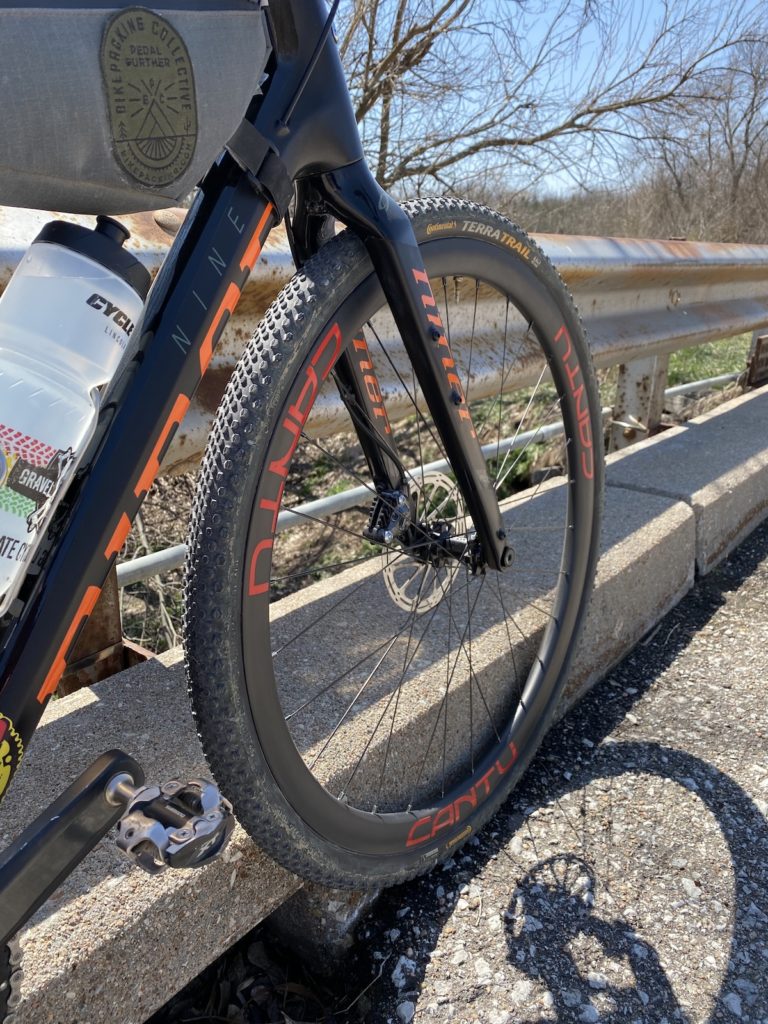Few companies have been building bicycle tires for as long as Continental, and the company’s tires are well respected in virtually every cycling discipline.
The Terra Speed and Terra Trail are the company’s latest gravel offerings, and I’ve been testing a set for more than six months. I’ve ridden the tires on numerous bikes in both normal riding and racing conditions. Today, I’ll break down the highs and lows of their performance.
Models and Options
The Terra Trail and Terra Speed have similar tread patterns, with alternating rows of hexagonal-shaped lugs. Continental uses its exclusive “Black Chili” rubber compound, which is said to deliver enhanced traction without compromising long-term durability.
Viewing the two models side-by side, it’s easy to see the larger, taller, more heavily siped transition and cornering lugs on the Terra Trail. In theory, this should make the Terra Trail a better choice for traction in loose conditions, presumably at the expense of a bit of speed on smooth roads, and a few extra grams on the scale.
Continental offers both Terra tires for 650b or 700c wheels, all with a folding aramid bead and high quality 180tpi “ProTection” casing. Terra Speed models are available in a choice of 35mm or 40mm widths, while the Terra Trail is offered in a 40mm width only.
Claimed weight for the 700x40c Terra Trail is 460g, while the same size Terra Speed is claimed to weigh 420g. My test samples were roughly 20g lighter than claimed, at 438g for the Terra Trail and 402g for the Terra Speed. Impressive.
MSRP for the Terra Trail and Terra Speed is $64.95 each.
Installation and Tubeless Setup
I like my bikes to have a bit more cornering bite up front, so I chose a Terra Trail for the front, and a Terra Speed for the rear, both in 700x40c size. The tires were easy to mount and set up tubeless on the Cantu Rova test wheels (24mm internal width).
After 48 hours inflated to 35psi, the Terra Trail measured a full 40mm in width at the tips of the cornering knobs. The Terra Speed measured 39mm in width, mostly due to the smaller outer cornering knobs. The casings appear identical between the two tires.
On the Road
The combination of the front Terra Trail and rear Terra Speed proved to be a good one, with smooth, fast rolling and plenty of traction in most situations. Durability has also been very good, with minimal visible wear after more than 600 miles on the road.
For my 165 lbs plus kit, I found a good balance of rolling and ride quality around the 35psi mark. The casings seemed to break in after 3-4 rides, after which ride quality became noticeably more supple. That said, the Continental casings felt less forgiving than the tan wall WTB Riddlers they replaced – a bit of a surprise. Ride quality wasn’t bad, nor was it a major highlight of the tires’ performance.
Traction and cornering with the Terra Trail/Terra Speed combination was predictable overall over a wide range of gravel or dirt surfaces. The only situation the tires struggled with was hard, dry road surfaces with loose gravel on-top. Here, the Terra Speed would occasionally break loose under power when climbing out of the saddle.
The Terra Trail could be trusted more in loose conditions, likely due to the larger, deeper knobs across the tire crown. Cornering was predictable, and I surprised myself a few times with the lines I was able to choose in loose gravel corners with the Terra Trail leading the way.
In tackier dirt and gravel, the Terra Trail/Terra Speed combination was fun to ride, with fast rolling and plentiful traction. I encountered mud just a handful of times during testing, and while not designed as mud tires, the Terra tires shed mud quickly. This allowed me to keep rolling in situations where other riders had to stop to clean their bikes out.
Compared to other 40c gravel tires available today, the Terra Trail and Terra Speed are on the smaller end of the spectrum when it comes to air volume. This was most noticeable on rides that included singletrack with roots or rocks. In these conditions, I found I needed to run higher pressure to ward off rim strikes than with other similarly-sized tires.
That’s not to say the Terra Trail and Terra Speed are bad tires. They’re lightweight gravel tires, not mountain bike tires. Those looking for downsized mountain bike tires can find plenty of options that will suit their needs better. That said, those options will likely be heavier and slower rolling on the gravel than these Continental tires are.
The Bottom Line
It’s amazing how good gravel tires are today, and these new Continental tires are great examples of the progress gravel tires have made. They’re not much heavier than a road tire, yet are true 40c treaded tires that can confidently be ridden in nearly any gravel conditions. In their element, they’re fast, predictable and durable. And while clearly not mountain bike tires, the Terra Trail and Terra Speed won’t hold you back on routes that include sections of smooth singletrack either.
Head over to the Continental Tires website to learn more about the Terra Trail and Terra Speed gravel tires.
Please note: Continental Tires sent the Terra Trail and Terra Speed gravel tires to Riding Gravel at no charge for test and review. We were not paid, nor bribed for this review and we strive to give our honest thoughts and views throughout.

